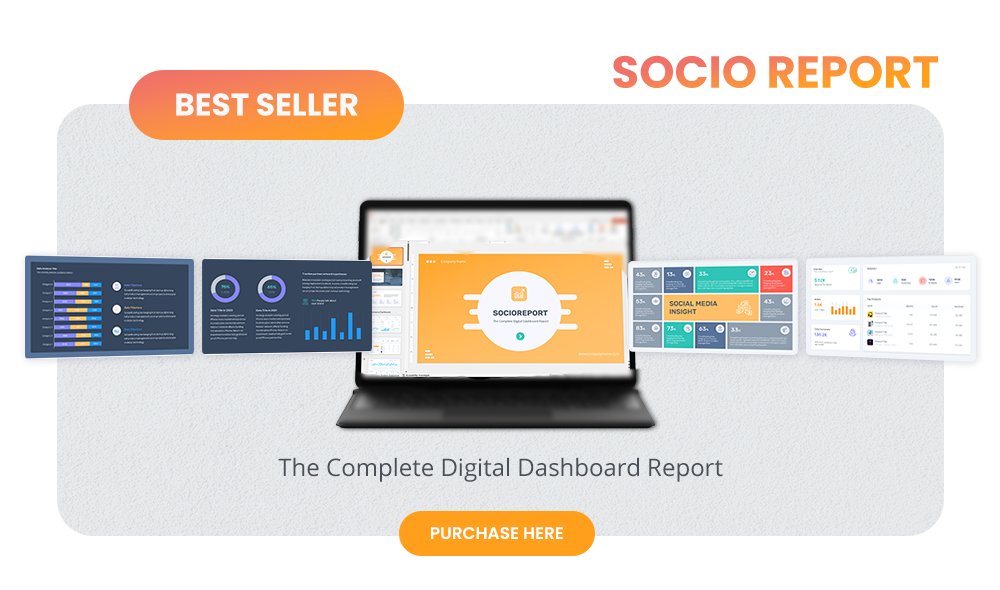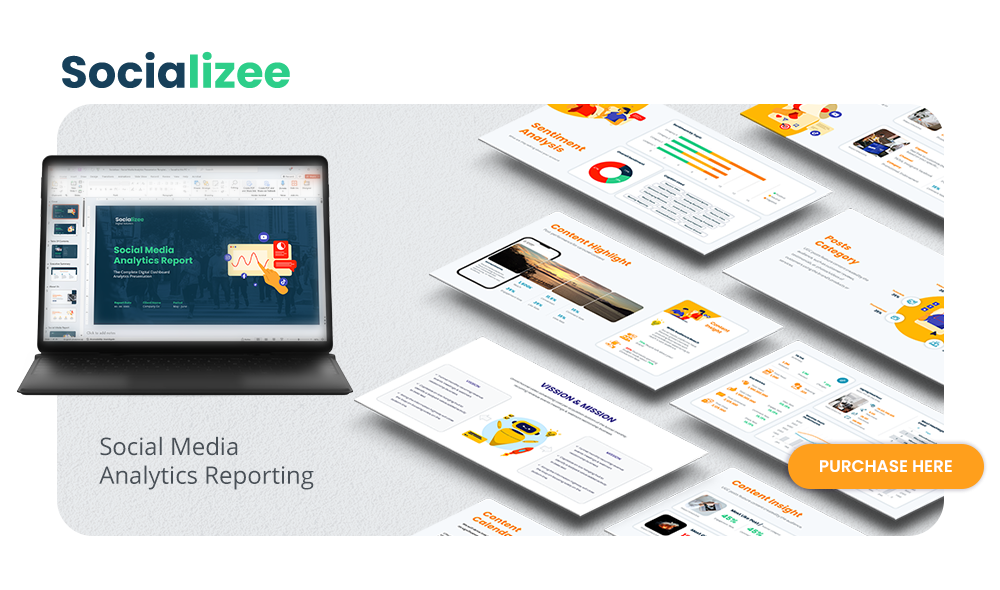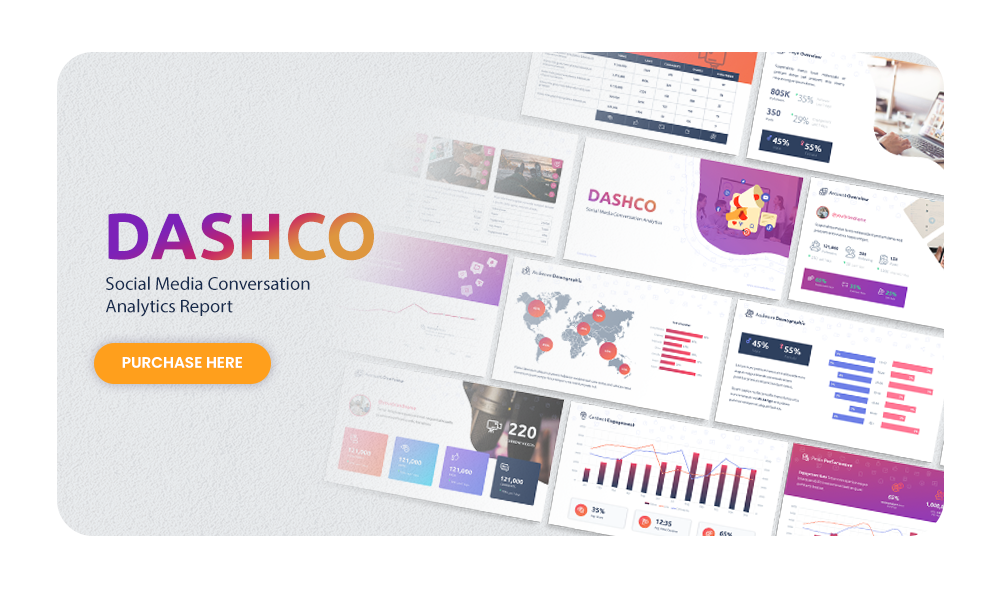The Ultimate Social Media Report Template: Analyze, Optimize, and Excel in Your Digital Marketing Strategy
Are you looking to take your social media marketing strategy to the next level? Look no further! With our ultimate social media report template, you can analyze, optimize, and excel in your digital marketing efforts.
Providing a comprehensive overview of your social media performance, this template is a game-changer for businesses of all sizes. Whether you're a social media manager, a small business owner, or a digital marketer, this template will streamline your reporting process, saving you time and effort.
Our social media report template is designed to help you track key metrics, such as engagement rates, reach, and conversions, allowing you to identify what's working and what needs improvement. Armed with this valuable data, you can make informed decisions to optimize your social media campaigns and drive better results.
So what are you waiting for? Download our ultimate social media report template today and start analyzing, optimizing, and excelling in your digital marketing strategy. Get ready to take your social media game to new heights!
Why is social media reporting important?
Social media reporting plays a critical role in any digital marketing strategy. It provides you with valuable insights into the performance of your social media campaigns and helps you understand how your audience is interacting with your content. By analyzing the data from your social media reports, you can make data-driven decisions and optimize your strategy for better results.
One of the key reasons why social media reporting is important is that it allows you to track and measure the success of your social media campaigns. Without proper reporting, it's challenging to determine the effectiveness of your efforts. By monitoring key metrics such as engagement rates, reach, and conversions, you can gain a clear understanding of what's working and what's not.
Social media reporting also helps you identify trends and patterns in your audience's behavior. By analyzing the data from your reports, you can uncover insights about your target audience's preferences, interests, and demographics. This information can be used to tailor your content and messaging to better resonate with your audience.
In addition, social media reporting enables you to set realistic goals and objectives for your social media campaigns. By tracking your progress against these goals, you can evaluate the success of your strategies and make necessary adjustments along the way.
Key metrics to include in your social media report
When it comes to social media reporting, there are several key metrics that you should include to get a comprehensive view of your performance. These metrics will help you understand how your audience is engaging with your content and whether your social media efforts are driving the desired results. Here are some key metrics to consider:
- Engagement Rate: This metric measures how actively your audience is interacting with your social media content. It includes likes, comments, shares, and other forms of engagement. A high engagement rate indicates that your content is resonating with your audience and generating interest.
- Reach: Reach measures the number of unique users who have seen your social media content. It provides insights into the visibility and exposure of your posts. Increasing your reach can help you expand your audience and increase brand awareness.
- Conversions: Conversions track the number of desired actions taken by your audience, such as signing up for a newsletter, making a purchase, or filling out a form. This metric helps you evaluate the effectiveness of your social media campaigns in driving tangible results.
- Click-Through Rate (CTR): CTR measures the percentage of users who click on a link in your social media post. It indicates the level of interest and engagement generated by your content. A high CTR suggests that your content is compelling and persuasive.
- Follower Growth: Tracking the growth of your social media followers is essential for measuring the success of your efforts in building an audience. A steady increase in followers indicates that your content is resonating with your target audience and attracting new followers.
Including these key metrics in your social media report will give you a holistic view of your performance and help you identify areas for improvement. Remember to customize your report based on your specific goals and objectives.
Setting goals and objectives for your social media report
Setting goals and objectives for your social media report is crucial for measuring the success of your social media efforts. Without clear goals, it's challenging to determine whether your strategies are effective or not. Here are some tips for setting goals and objectives for your social media report:
- Align with your overall marketing objectives: Your social media goals should align with your overall marketing objectives. For example, if your marketing objective is to increase brand awareness, your social media goal could be to increase reach and engagement.
- Make your goals SMART: SMART stands for Specific, Measurable, Achievable, Relevant, and Time-bound. Ensure that your goals meet these criteria. For example, instead of setting a vague goal like "increase engagement," set a specific goal like "increase engagement rate by 10% within three months."
- Break down your goals: Break down your goals into smaller, actionable objectives. This will help you track your progress and make adjustments as needed. For example, if your goal is to increase conversions, your objectives could be to optimize your landing pages, improve your call-to-action, and run targeted ad campaigns.
- Track your progress: Regularly monitor and track your progress against your goals. This will help you identify areas for improvement and make data-driven decisions to optimize your social media strategy.
Setting clear goals and objectives for your social media report will provide you with a roadmap for success and help you measure the impact of your social media efforts.
Choosing the right social media reporting tools
Choosing the right social media reporting tools is essential for effectively tracking and analyzing your social media performance. With so many tools available, it can be overwhelming to find the one that best suits your needs. Here are some factors to consider when choosing social media reporting tools:
- Integration with social media platforms: Ensure that the reporting tool integrates seamlessly with the social media platforms you use. This will allow you to directly access and analyze your data without any hassle.
- Customizable reporting: Look for tools that offer customizable reporting features. This will allow you to tailor your reports to include the metrics and data that are most relevant to your business goals.
- Real-time data: Real-time data is crucial for staying updated on your social media performance. Choose a tool that provides real-time data so that you can make timely decisions and adjustments to your social media strategy.
- Ease of use: The reporting tool should be user-friendly and intuitive. It should provide a clear and easy-to-understand interface that allows you to navigate and analyze your data effortlessly.
- Advanced analytics: Advanced analytics features, such as data visualization and trend analysis, can provide deeper insights into your social media performance. Look for tools that offer these advanced features to gain a better understanding of your data.
By carefully considering these factors, you can choose the right social media reporting tools that will simplify your reporting process and provide you with valuable insights to optimize your social media strategy.
Analyzing and interpreting social media data
Analyzing and interpreting social media data is a crucial step in the reporting process. It allows you to gain valuable insights into your social media performance and make data-driven decisions to optimize your strategy. Here are some tips for analyzing and interpreting social media data:
- Compare data over time: Compare your social media data over different time periods to identify trends and patterns. Look for any significant changes in metrics such as engagement rates, reach, and conversions. This will help you understand the impact of your strategies and campaigns.
- Segment your data: Segment your data by different variables such as demographics, location, and interests. This will help you identify specific audience segments that are performing well or underperforming. Use this information to tailor your content and messaging to better resonate with each segment.
- Benchmark against competitors: Benchmarking your social media performance against your competitors can provide valuable insights into your industry landscape. Compare your metrics with those of your competitors to identify areas where you can improve and gain a competitive advantage.
- Look for correlations: Look for correlations between different metrics to uncover insights. For example, if you notice a correlation between engagement rates and specific types of content, you can focus on creating more of that content to drive higher engagement.
- Identify outliers: Identify any outliers in your data that deviate significantly from the norm. These outliers can provide valuable insights into what's working or not working in your social media strategy. Dig deeper into these outliers to understand the reasons behind them and make necessary adjustments.
Analyzing and interpreting social media data requires a combination of analytical skills and creativity. By following these tips, you can gain valuable insights into your social media performance and make data-driven decisions to optimize your strategy.
Identifying trends and patterns in your social media report
Identifying trends and patterns in your social media report is crucial for understanding the behavior of your audience and making informed decisions to optimize your strategy. By analyzing your data, you can uncover insights that will help you create more targeted and effective social media campaigns. Here are some tips for identifying trends and patterns in your social media report:
- Track changes over time: Analyze your data over different time periods to identify any changes or trends. Look for any significant increases or decreases in metrics such as engagement rates, reach, and conversions. This will help you understand the impact of your strategies and campaigns.
- Look for recurring themes: Identify any recurring themes or topics that resonate with your audience. This could be specific types of content, hashtags, or messaging. By understanding what resonates with your audience, you can create more targeted and relevant content.
- Identify peak engagement times: Analyze your data to identify the times of day or days of the week when your audience is most active and engaged. This will help you optimize your posting schedule to reach your audience when they are most likely to see and engage with your content.
- Analyze audience demographics: Analyzing the demographics of your audience can provide insights into their preferences and interests. Look for any patterns or trends in the demographics data to better understand your target audience and tailor your content to their needs.
- Monitor industry trends: Stay up to date with the latest industry trends and news. Analyze your data in the context of these trends to identify opportunities for innovation and improvement in your social media strategy.
By identifying trends and patterns in your social media report, you can gain a deeper understanding of your audience and create more targeted and effective social media campaigns.
Optimizing your social media strategy based on report insights
Optimizing your social media strategy based on the insights from your social media report is essential for driving better results and achieving your marketing goals. By analyzing your data and identifying areas for improvement, you can make data-driven decisions and take actions to optimize your strategy. Here are some tips for optimizing your social media strategy based on report insights:
- Focus on high-performing content: Identify the types of content that are generating the highest engagement rates, reach, and conversions. Double down on creating more of this content to maximize your impact. Use your report insights to refine your content strategy and create content that resonates with your audience.
- Experiment with different formats: Your report insights may reveal that certain formats of content perform better than others. For example, you may find that videos generate higher engagement rates than images. Use this information to experiment with different formats and find the ones that work best for your audience.
- Optimize posting schedule: Analyze your report to identify the times of day or days of the week when your audience is most active and engaged. Use this information to optimize your posting schedule and reach your audience when they are most likely to see and engage with your content.
- Test different messaging and CTAs: Your report insights can provide valuable insights into the messaging and calls-to-action (CTAs) that resonate with your audience. Test different messaging and CTAs to find the ones that drive the highest conversions. Use A/B testing to experiment with different variations and measure their impact.
- Engage with your audience: Social media is all about building relationships and engaging with your audience. Use your report insights to identify opportunities for engagement and interaction. Respond to comments, messages, and mentions to show your audience that you value their feedback and opinions.
By optimizing your social media strategy based on the insights from your report, you can drive better results, increase engagement, and achieve your marketing goals.
Creating a visually appealing and easy-to-understand social media report template
Creating a visually appealing and easy-to-understand social media report template is essential for effectively communicating your data and insights. A well-designed report template will make it easier for stakeholders to understand and interpret the information. Here are some tips for creating a visually appealing and easy-to-understand social media report template:
- Use visual elements: Incorporate visual elements such as charts, graphs, and infographics to present your data in a visually appealing way. Visuals can help simplify complex information and make it easier for readers to understand.
- Highlight key metrics: Highlight the key metrics that are most relevant to your goals and objectives. Use color-coding or bold text to draw attention to these metrics and make them stand out.
- Organize your data: Organize your data in a logical and easy-to-follow manner. Use headings, subheadings, and bullet points to structure your report and make it scannable. This will help readers quickly find the information they're looking for.
- Include explanations and insights: Provide explanations and insights alongside your data to help readers understand the context and significance of the metrics. This will make your report more informative and actionable.
- Keep it concise: While it's important to provide sufficient information, it's also crucial to keep your report concise and to the point. Avoid unnecessary jargon or technical terms that may confuse readers. Use clear and concise language to communicate your insights effectively.
Take a look our presentation template that ready for you to create social media report presentation in a minute
SocioReport
Unlock the power of data-driven decision-making with SocioReport, a comprehensive dashboard presentation report designed for social media managers, web analysts, and digital marketers. SocioReport enables you to seamlessly transform intricate data into actionable insights, allowing you to optimize your online presence and achieve success in the digital landscape.
Socializee
Elevate your social media analytics reports with Socializee, the ultimate presentation template crafted for social media managers, digital marketers, and agencies. Socializee empowers you to create persuasive and professional reports that convert complex data into actionable insights. This template aids in optimizing social media strategies and achieving digital success with its visually appealing design.
SocioTrend
Empower your presentations with SocioTrend, the ultimate Social Media Analytics Presentation Template. Tailored for professionals, this engaging and user-friendly template seamlessly blends insightful analytics with captivating design. SocioTrend helps your data-driven narratives stand out effortlessly, enabling you to elevate your social media strategy, captivate your audience, and make informed decisions.
DashCo
Unlock the power of data visualization and make your social media analytics presentations impactful with DashCo. This professionally crafted presentation template is designed to elevate your reports, captivate your audience, and streamline your data-driven storytelling. DashCo enables you to make your data visually compelling, ensuring your message is conveyed effectively.
By following these tips, you can create a visually appealing and easy-to-understand social media report template that effectively communicates your data and insights.
Conclusion: Leveraging social media reporting to excel in your digital marketing strategy
In conclusion, social media reporting is a powerful tool that can help you analyze, optimize, and excel in your digital marketing strategy. By tracking key metrics, setting goals, and analyzing your data, you can make data-driven decisions and take actions to improve your social media performance.
Remember to choose the right social media reporting tools, analyze and interpret your data










